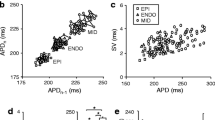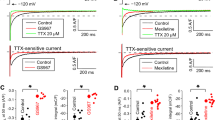Summary
The present study was designed to combine the monophasic action potential (MAP) recording technique with a well-established canine isolated, bloodperfused ventricular septum preparation for examining, simultaneously, electrical and mechanical drug-induced changes. A MAP catheter was positioned onto the base of a papillary muscle for recording the local MAP, using a manual micromanipulator together with a commercially available catheter sheath to keep the optimal contact pressure against the ventricular wall. The catheter sheath was filled with saline to eliminate the background electrical noise. Tetrodotoxin, disopyramide, lidocaine, and verapamil were used to clarify the potential utility of the preparation. Tetrodotoxin and lidocaine shortened the MAP duration, while disopyramide prolonged it. Verapamil slightly shortened the MAP duration but not significantly. Each drug showed negative inotropic and coronary vasodilator effects. Sodium channel blockers slowed intraventricular conduction and decreased the maximum upstroke velocity of MAP, while verapamil showed no effects. These results suggest that utilization of the bloodperfused ventricular septum preparation together with MAP recording will become a valuable model for evaluating drugs with multiple sites of action on cardiac muscles.
Similar content being viewed by others
References
Echt DS, Liebson PR, Mitchell LB, Peters RW, Obias-Manno D, Barker AH, Arensberg D, Baker A, Friedman L, Greene HL, Huther ML, Richardson DW (The CAST Investigators) (1991) Mortality and morbidity in patients receiving encainide, flecainide, or placebo. The Cardiac Arrhythmia Suppression Trial. N Engl J Med 324:781–788
Sugiyama A, Motomura S, Hashimoto K (1994) Utilization of an isolated, blood-perfused canine papillary muscle preparation as a model to assess efficacy and adversity of class I antiarrhythmic drugs. Jpn J Pharmacol 66:303–316
Sugiyama A, Motomura S, Tamura K, Hashimoto K (1990) Comparison of cardiovascular effects of pirmenol with those of disopyramide in isolated canine heart preparations cross-circulated with a donor dog. Jpn J Pharmacol 53:97–110
Franz MR (1995) Monophasic action potential recording. In: Zipes DP, Jalife JJ (eds) Cardiac electrophysiology, from cell to bedside, 2nd edn. Saunders, Philadelphia, pp 1170–1178
Franz MR (1991) Method and theory of monophasic action potential recording. Prog Cardiovasc Dis 33:347–368
Franz MR (1994) Bridging the gap between basic and clinical electrophysiology: what can be learned from monophasic action potential recordings? J Cardiovasc Electrophysiol 5:699–710
Franz MR, Burkhoff D, Spurgeon H, Weisfeldt ML, Lakatta EG (1986) In vitro validation of a new cardiac catheter technique for recording monophasic action potentials. Eur Heart J 7:34–41
O'Donoghue S, Platia EV (1991) Monophasic action potential recordings: evaluation of antiarrhythmic drugs. Prog Cardiovasc Dis 34:1–14
Yuan S, Blomström-Lundqvist C, Olsson SB (1994) Monophasic action potentials: concept to practical applications. J Cardiovasc Electrophysiol 5:287–308
Franz MR, Flaherty JT, Platia EV, Bulkley BH, Weisfeldt ML (1984) Localization of regional myocardial ischemia by recording of monophasic action potentials. Circulation 69:593–604
Ino T, Karagueuzian HS, Hong K, Meesmann M, Mandel WJ, Peter T (1988) Relation of monophasic action potential recorded with contact electrode to underlying transmembrane action potential properties in isolated cardiac tissues: a systematic microelectrode validation study. Cardiovasc Res 22:255–264
Endoh M, Hashimoto K (1970) Pharmacological evidence of autonomic nerve activities in canine papillary muscle. Am J Physiol 218:1459–1463
Endoh M, Yanagisawa T, Taira N (1978) Effects of calcium-antagonistic coronary vasodilators, nifedipine and verapamil, on ventricular automaticity of the dog. Naunyn-Schmiedeberg's Arch Pharmacol 302:235–238
Usui T, Sugiyama A, Ishida Y, Satoh Y, Sasaki Y, Kiyosawa K, Hashimoto K (1998) Simultaneous assessment of the hemodynamic, cardiomechanical and electrophysiological effects of terfenadine on the in vivo canine model. Heart Vessels 13:49–57
Endresen K, Amlie JP (1989) Acute effects of lidocaine on repolarization and conduction in patients with coronary artery disease. Clin Pharmacol Ther 45:387–395
Edvardsson N, Hirsch I, Olsson SB (1984) Acute effects of lignocaine, procainamide, metoprolol, digoxin and atropine on human myocardial refractoriness. Cardiovasc Res 18:463–470
Edwards IR, Martin JF, Ward JW (1976) The effects of disopyramide on in vivo measurement of monophasic action potential in canine heart muscle. J Int Med Res 4 (Suppl):26–30
Landmark K, Amlie JP (1976) A study of the verapamilinduced changes in conductivity and refractoriness and monophasic action potentials of the dog heart in situ. Eur J Cardiol 4:419–427
Sugiyama A, Hashimoto K (1998) Effects of gastrointestinal prokinetic agents, TKS159 and cisapride, on the in situ canine heart assessed by cardiohemodynamic and electrophysiological monitoring. Toxcol Appl Pharmacol 152:261–269
Sugiyama A, Aye NN, Katahira S, Saitoh M, Hagihara A, Matsubara Y, Hashimoto K (1997) Effects of nonsedating antihistamine, astemizole, on the in situ canine heart assessed by cardiohemodynamic and monophasic action potential monitoring. Toxicol Appl Pharmacol 143:89–95
Sugiyama A, Aye NN, Katahira S, Hagihara A, Hashimoto K (1997) Effects of magnesium sulfate on the canine cardiovascular system complicating astemizole overdose. J Cardiovasc Pharmacol 29:795–800
Sugiyama A, Ni C, Arita J, Eto K, Xue YX, Hashimoto K (1996) Effects of the antihypoxic and neuroprotective drug, lubeluzole, on repolarization phase of canine heart assessed by monophasic action potential recording. Toxicol Appl Pharmacol 139:109–114
Shinozaki T, Satoh S, Miura M, Iwabuchi K, Takeuchi M, Suzuki S, Baba S, Katoh H, Funakoshi M, Keitoku M, Watanabe J, Ishide N, Shirato K (1997) The rise time of the monophasic action potential — a new index of local use-dependent conductivity by sodium channel blockers in human myocardium. Jpn Circ J 61:979–987
Xu J, Zaim S, Pelleg A (1996) Effects of pinacidil, verapamil, and heart rate on afterdepolarizations in the guinea-pig heart in vivo. Heart Vessels 11:289–302
Sims JJ, Winecoff AP, Ujhelyi MR (1997) Lidocaine does not affect myocardial electrical heterogeneity: implication for low proarrhythmic actions. Pharmacotherapy 17:1267–1273
Xie JT, January CT (1993) The monophasic action potential technique and its application in cardiac electrophysiology. Methods Find Exp Clin Pharmacol 15:557–567
Author information
Authors and Affiliations
Additional information
This study was supported in part by a Grant-in-Aid for Scientific Research (08770064) from the Japanese Ministry of Education, Science and Culture.
Rights and permissions
About this article
Cite this article
Hagihara, A., Sugiyama, A. & Hashimoto, K. Effects of antiarrhythmic drugs on the monophasic action potential of the canine isolated, blood-perfused ventricular septum preparation. Heart Vessels 13, 181–188 (1998). https://doi.org/10.1007/BF01745042
Received:
Revised:
Accepted:
Issue Date:
DOI: https://doi.org/10.1007/BF01745042




